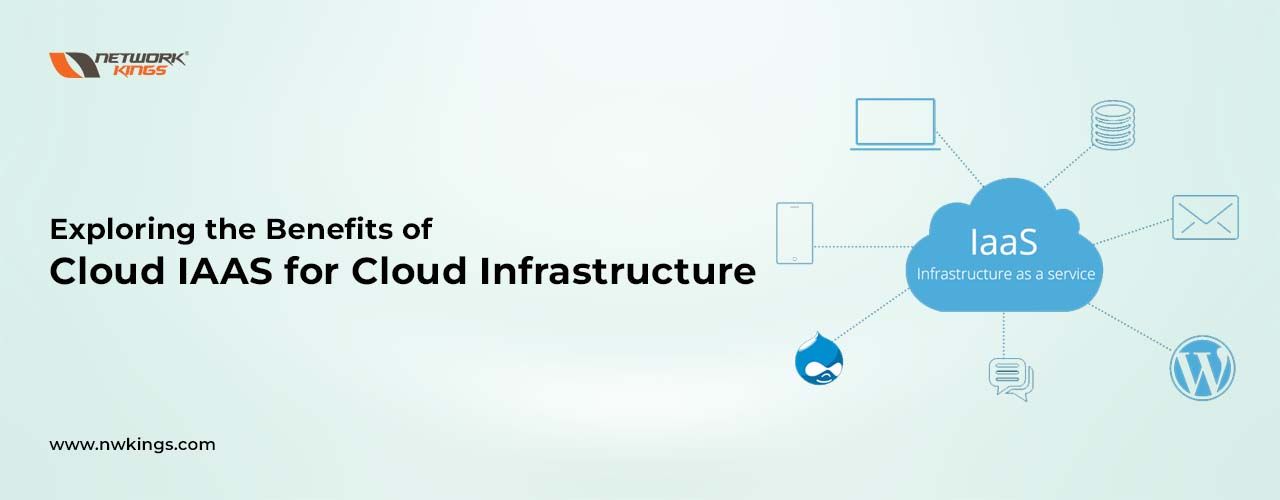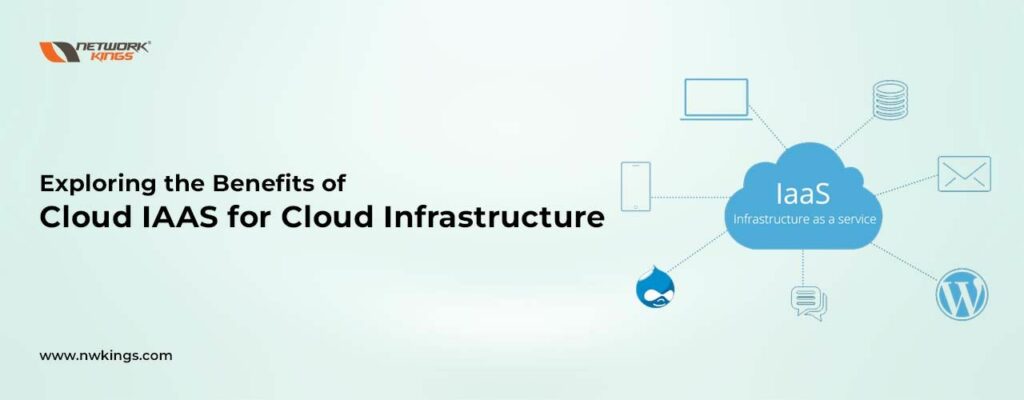
Cloud Infrastructure as a Service, i.e., IAAS in cloud computing, is shaking up the way businesses are taking advantage of cloud computing. It allows organizations to get their hands on high-end infrastructures without needing to splash out on extra hardware or software. With IAAS, IT experts can instantly roll out and monitor applications in a safe yet cost-effective manner.
In this blog post, we will be delving into the fundamentals of IAAS, its benefits and platform options – plus how companies today are tapping into all that IAAS has to offer for their cloud needs.
Understanding the Basics of IAAS in Cloud Computing

The usage of cloud computing has skyrocketed over recent years since it is a way for companies to get their IT systems up and running easily and cost-effectively. If you are mulling over using cloud services, understanding Infrastructure as a Service (IaaS) first is pivotal.
Put simply, IaaS is an offshoot of cloud computing which provides computer infrastructure such as virtual machines, storage solutions, network configurations etc., similar to utilities at your disposal whenever needed.
Essentially, most IaaS solutions offer the ability to set up servers quickly with a range of different configurations – making them ideal for businesses that experience varying or unpredictable workloads.
These services are normally charged based on usage or capacity and you can easily access various types of bandwidth and redundancy levels. The main advantage of using IaaS is that it allows much higher scalability when compared to conventional data centre resource provisioning – this could be an invaluable asset if your business needs vary over time.
When demand increases, you can easily and quickly add more resources with minimal effort on your part. On the flipside, if there’s an unforeseen decrease in requirement then just as simply these assets can be taken away or reduced. This level of responsiveness and suppleness makes it perfect for web-based projects or any other project which needs quick changes due to sudden rushes of activity over short periods.
One extra benefit when using IaaS providers is that they usually operate their platforms on extremely dependable hardware meaning increased reliability than running your data center network – making this option suitable even for mission-critical applications.
That being said, it is key to keep in mind that depending on what type of application you need to run on IaaS there could be some restrictions regarding availability since it relies upon an external provider so a few further safety measures may have to be implemented from your side such as setting up multiple layers of redundancy between suppliers.
Could we rely solely upon Cloud Infrastructure? Are different cloud infrastructure providers enough to safeguard against unexpected outages?
Decoding the Concept of Cloud IAAS
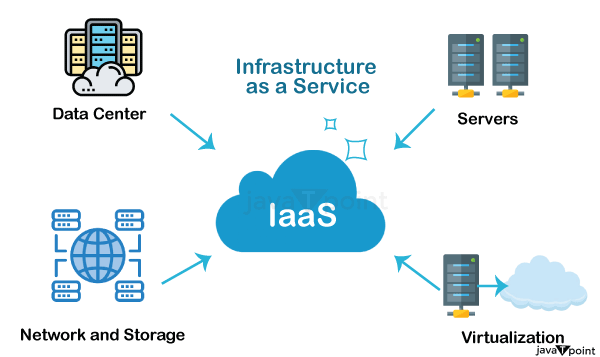
Cloud IAAS is a concept that’s still fresh in the world of cloud computing. It stands for Infrastructure as a Service, and it simply means getting services through the internet from an outside provider – think hosting companies. This type of service allows organisations to utilise virtualization and other technologies to build their digital IT infrastructure with minimal costs involved. Cloud IAAS provides access to vast amounts of data and computing strength without breaking into banks – no expensive hardware or software is needed!
The idea of Cloud Infrastructure as a Service is focused around the concept of allowing organisations to just pay for what they need rather than investing in one large initial outlay. It’s an attractive prospect because businesses can rent server space, storage capacity and bandwidth on demand without committing to buying any hardware or software at all.
This makes it cost-effective and more efficient compared with traditional strategies – meaning companies can grow their operations or add new capabilities quickly and easily while staying away from steep start-up costs that come along when purchasing technology outright. Ask yourself why this could be beneficial. Well, it’s likely due to only paying for exactly the resources you require!
Three major bits make up the Cloud IAAS offer: virtual machines, software stacks and automation. The virtual machines are basically “virtual renditions” of physical servers running on shared hardware resources; while the software stacks give access to apps such as web servers, databases and messaging systems; finally, automation allows companies to configure their services swiftly and simply with minimal effort from IT staff.
By making use of these components in addition to other advanced features such as storage replication and scalability, organisations can benefit from increased operational efficiency at lessened costs compared to traditional methods for obtaining IT infrastructure services.
All in all, Cloud IAAS is a cost-effective way for businesses to gain immediate access to powerful computing resources without having to invest heavily into hardware or software immediately. With its versatility advantages plus scalability benefits firms have even better command over their budgets whilst being able to enjoy swifter deployment times and lesser operating costs when contrasted with more conventional options for getting hold of IT infrastructure provisioning.
Exploring Different IAAS Platforms
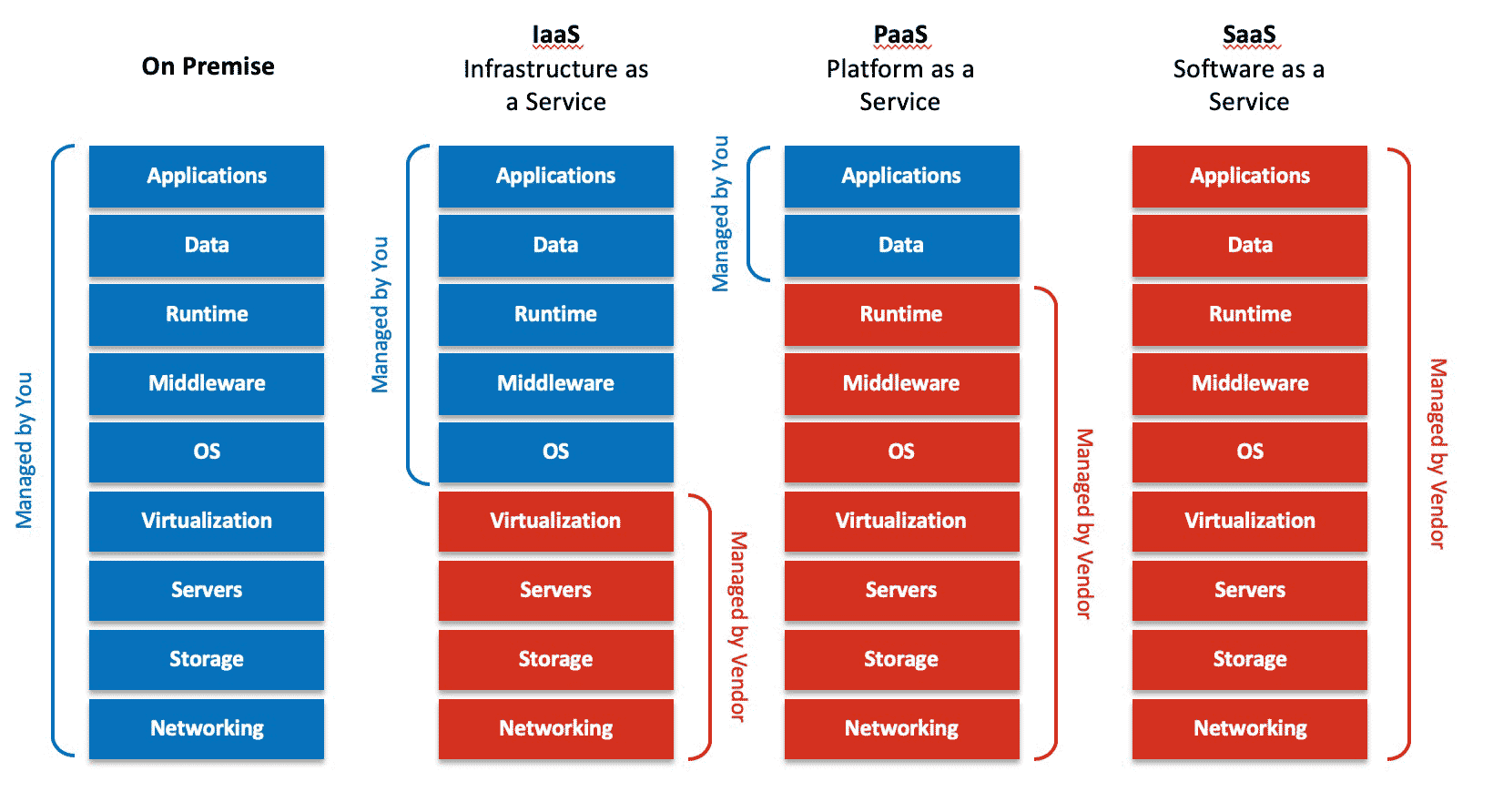
Exploring various IAAS platforms is a fundamental piece of any cloud computing mission. With the continuous increase in the number of cloud providers, and the broad range of services accessible, it is necessary to take your time researching what each platform provides about features, pricing structures, performance, security and scalability.
To make sure you get the utmost benefit from selecting an IAAS platform it makes sense to look into multiple vendors so that when deciding everything can be equated fairly. To begin this process first detail what exactly are your needs for an IAAS platform. What must this system do for you? What kind of workload are you dealing with? Are you on the lookout for applications that would need to have great performance or dependability?
Work out which IaaS services fit this requirement and reduce your list of vendors from there. When studying each provider, ponder their pricing structure, ask about support services and check if they have any bonus features that could be advantageous to you when it comes to scalability or security.
Plus, look into their service agreement conditions making sure conformity regarding data storage space and access as well as other essential contractual basics. Have these researchers taken all necessary measures in terms of compliance? Is there anything else we should consider before narrowing down our vendor choices?
Once you have done a bit of initial research into different providers and whittled down the choices based on your criteria (cost, performance requirements etc.), it’s time to put the IAAS platforms through their paces – this can normally be achieved via trial accounts or sandbox environments which are sometimes supplied by vendors before taking things further.
This will give you an idea of how accessible their interfaces are as well as whether they deliver satisfactory uptime levels for your individual needs plus shed some light on response times when responding to customer service queries etc.
Finally, make sure that whatever IAAS platform you go with is suitable not just in present circumstances but also 3 – 5 years down the line once business requirements change – ask yourself questions such as “Will this product grow along with me”; “Are there customisations available” etc., so that longterm sustainability/scalability of services used remains intact. Taking care at the outset like this will help save money and time later should upgrading or changing providers become necessary due to changes in business growth demands.
The Evolution of Cloud Infrastructure in the Modern World

Cloud infrastructure is becoming significantly more significant in the advanced world. To fully comprehend the development of cloud foundations nowadays’ computerized scene, it is key to have a fundamental comprehension regarding what it is and how it functions.
Cloud computing, every so often alluded to as Infrastructure as a Service (IaaS), is a sort of registering model which utilizes far-off servers facilitated on the web to store, oversee and process information rather than utilizing physical equipment situated in one area. This permits for improved adaptability and scalability for organizations however additionally has its downsides – why not use this opportunity?
It may look like cloud computing technology is a recent invention, but its origins stretch back to the 1960s. During this era, scientists began looking into connecting multiple computers across large distances and in turn helped shape what would become cloud computing many years later.
Then, 2006 saw AWS being established as one of the leading providers of virtual machines (VMs) storage, databases and application hosting services – cementing it firmly within modern technological advancements.
This was a significant step up in the development of cloud infrastructure as it allowed businesses to easily get their hands on highly adjustable resources that could be modified depending on what they needed without needing to put loads of money forward into physical hardware.
The widespread popularity of IaaS has resulted in more developments such as Platform as a Service (PaaS). PaaS solutions let users take advantage of services like application frameworks and database management which can help accelerate their growth process while simultaneously shifting operations into the cloud.
As a result, organisations all around were able to fit their workflows very quickly according to market changes with minimal cost and effort for those involved. Fast-forwarding today, we see how cloud infrastructure is continuing its progression due to new improvements such as serverless architecture or Functions as a Service (FaaS).
With these kinds of services, companies gain entryway towards higher levels of automation by permitting certain tasks or applications to operate autonomously without requiring manual interference from end-users thus making enterprise processes far more effective than ever before whilst drastically reducing time-to-market with the latest products or services. Pretty incredible stuff!
Benefits of Implementing IAAS in Business
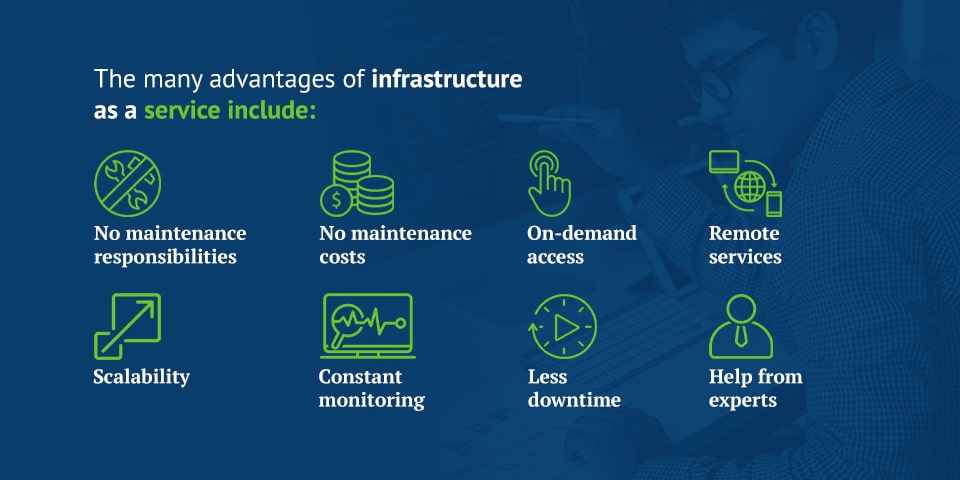
Cloud computing is gaining traction amongst businesses who are searching for ways to turn up efficiency, save some cash and enhance productivity. Infrastructure-as-a-Service (IaaS) stands as one of the most sought-after cloud computing models with a plethora of advantages it brings for enterprise owners as well as IT professionals. Putting IaaS into practice inside a business can bring about sweeping changes in its internal processes – something you’d find hard to believe without experiencing first-hand!
The main plus point offered by IaaS has got to be scalability. Companies have the freedom to scale their infrastructure according to ever-increasing needs quickly yet smoothly without having to shell out extra costs on hardware equipment. Wanna add more storage space? All that’s required is just a few clicks – nothing else!
This scalability allows businesses to cut down on costs since they just pay for what they use. With IaaS, companies get more flexibility when it comes to applications and development tools as well. Rather than an elaborate server or data centre needing to be tailored specifically for their needs, there are preconfigured options available that would best suit them. What’s even better is virtual machines negate the possibility of hardware incompatibility too – a bonus!
Businesses taking up IaaS don’t have to be concerned about vendor lock-in either; all services are provided by the provider however customers keep control over their system components, such as operating systems and applications which enable them straightforward access to switch services if necessary.
What’s more, with a wide selection of features offered by cloud suppliers like firewalls, load balancers or even databases it might not be essential for organisations to bother about software upgrades ever again since these qualities will probably get automatically kept up-to-date by the supplier permitting them greater adaptability than before. Could this mean companies can now benefit from better customer experiences?
Managed services are another great boon that IaaS offers; potential issues are spotted ahead of time, allowing IT resources to focus on finding solutions rather than getting bogged down in technical details – this way businesses not only save time but also money and energy spent on managing intricate technical operations and keeping an eye over the state of their systems all along.
By integrating IaaS into their activities, businesses can get speedy access to necessary tools while drastically cutting monetary risks due to regular monthly payments – from networking structures right through application layer hosting is taken care of by the supplier leaving customers stress-free when it comes to most maintenance tasks needed for traditional infrastructures as well as significantly diminishing total operational costs with improved performance results enabled by automatic scaling capabilities given out by cloud providers.. So why bother spending heavily upfront when you could just pay a fixed fee?
Key Features of Top Cloud IAAS Providers

When it comes to cloud computing IaaS, businesses have a lot of things to consider – not least which service provider offers the best features. It is essential to compare different options when picking out the right IAAS provider as services on offer vary significantly from one company to another. Most top providers of IAAS in cloud computing provide key features and benefits that are worth taking into account.
Of course, scalability is high up on this list; being able to quickly increase or decrease storage capacity can make all the difference for companies relying heavily on their IT system’s day-to-day operations.
When it comes to reliable IAAS cloud providers, businesses can rest assured that they will be provided with an easy and convenient system of adding resources like memory or storage space whenever required. This way companies don’t have to invest too much in hardware infrastructure when scaling up their operations as the need arises.
Rhetorical Question: But what about security? Indeed, top-tier IAAS service providers also come equipped with robust security measures ensuring all data stored on the clouds is adequately protected from potential unauthorized access or digital threats – something essential for any business today!
When it comes to security, most leading IAAS providers use encryption technologies, firewalls and other cutting-edge security measures to protect customer data. This is vital for businesses that rely on their cloud infrastructure or applications since any breach could lead to catastrophic losses – financial as well as with regards reputational damage.
What about reliability? Well, this is a big part of the IaaS deal too; Data centres need continuous monitoring and maintenance if they are going to stay alive around the clock without interruption of service so companies using advanced systems and processes which guarantee high availability during any time frame can be very attractive options indeed! Businesses investing in moving operations into clouds demand this kind of assurance after all.
At length, firms should take into account customer assistance services when settling on an IAAS provider in the cloud computing sector. A dependable supplier ought to provide support round-the-clock so that any difficulties can be settled quickly and competently wherever practicable – this could make all the difference for a firm’s triumph or failure whilst executing applications remotely within the cloud setting.
By thoroughly assessing each option and prioritizing these focal points, organisations can guarantee they find an IAAS provider who can fulfil their exact requirements while permitting them to gain from greater operational effectiveness as well as keeping costs low simultaneously. But what does it mean for businesses? Does improved availability always result in better service?
Breaking Down the Cost Aspects of Cloud IAAS
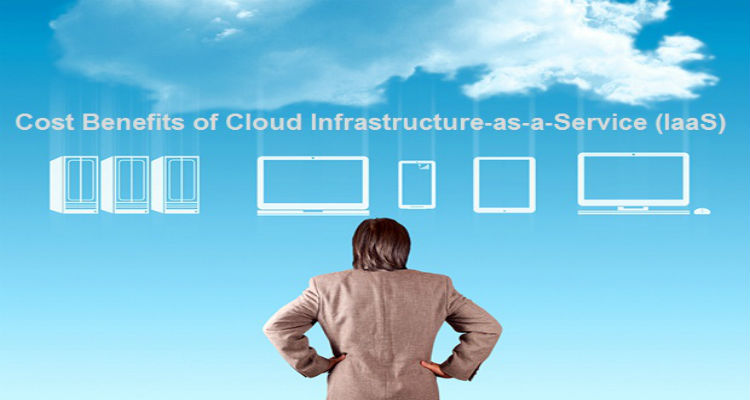
Cloud IAAS is one of the most talked about services in cloud computing, so it’s essential to break down and comprehend what goes into the cost. IAAS stands for Infrastructure as a Service which implies that customers can access storage, networks, and other computing resources on the cloud. Not only does IAAS provide availability to assets, but it additionally accompanies the additional advantage of scalability.
This means organisations can pay for more or less relying upon their requirements. But how does this all amount to? Is there an equation we ought to remember when pricing? How easy would it be if getting charged by usage was our go-to option?!
Considering the cost of IAAS in cloud computing, it is vital to factor in all related charges such as infrastructure fees and software licenses. Storage capacity is an example of a fee associated with your usage – companies pay depending on how much space they are occupying. And then there are also software licences that you may need to use when running applications like Microsoft Office or Adobe Creative Cloud products on your servers; this could turn out pretty costly too! What other additional costs should one be aware of before taking up a subscription?
The cost of IAAS in cloud computing can be prohibitively expensive for small businesses or those just starting their digital journey, so it’s essential to consider the pros and cons of a system or service before investing. What’s more, running expenses such as upkeep and staff also figure into the cost equation. Maintenance requires that servers are functioning at optimal levels with up-to-date security protocols while staffing involves recruiting IT engineers who understand how to identify any possible issues down the line.
When it comes to Cloud IAAS, there are a lot of potential costs that you need to be aware of. Many cloud providers offer some level of support in their monthly services – but if you require extra help then that could come at an additional cost too so make sure you have all the info beforehand about what will be billed separately from your overall bill. Rhetorical question: How do I evaluate my budget when looking into the different factors involved with Cloud IAAS?
It’s essential to consider things like infrastructure fees, software licensing costs and maintenance expenditure; not forgetting any staff costs depending on how complex your set-up is! Bottom line: before making long-term commitments ensure that solutions fit both with business goals AND wallet size – otherwise, those hidden extras can soon add up!
Case Studies Illustrating the Success of IAAS in Business
Case studies are a great way of showing just how advantageous IAAS can be for businesses. They provide hard evidence that an organisation has been able to use the technology to overcome obstacles and reach its goals, so let us take a look at some case studies where cloud platform providers have greatly benefited both large and small companies in the transportation industry. What these accounts make clear is that they help organisations get up and running fast with timely leases and managed services – super useful when time is tight!
Let’s take the example of Singapore-based Cloud Fleet Solutions. By joining forces with Google Cloud Platform, they managed to develop a dashboard which gave their customers real-time access to vehicle location data and analytics – something that has been incredibly useful in streamlining operations, cutting costs and improving customer experiences.
The retail sector is another one where IAAS (Infrastructure as a Service) has made an enormous difference too; particularly when it comes to putting together omnichannel strategies. Take for instance GourmetGiftBaskets.com: leveraging AWS’ cloud services enabled them to grow quickly enough so they could meet sudden surges in demand without having to splurge on expensive infrastructure first up front or all at once!
IAAS can offer tremendous advantages for businesses of all sizes and sectors – leading to more and more organizations taking it on as part of their technology strategy. With its agility and scalability benefits, even the healthcare industry is looking towards IAAS. For instance, 911inform – a public safety software company – deployed IBM Cloud Private for its emergency management system solution due to its capacity with dealing complex data processing tasks while still adhering to HIPAA regulations; something which would have taken too long or cost too much using traditional infrastructure solutions alone.
And then we come back around again full cycle, from cloud services like e-commerce platforms being able to keep up pace with rapid growth whilst making sure customers are content across multiple channels – all by one platform – right through o having access to reliable computing resources when needed via an appropriate IAAS solution! So whether you are searching for secure platform scaling up operations or require quick prompt use of computerised service: chances are there will be a perfect fit out there!
Potential Challenges in Incorporating IAAS into Business

When it comes to cloud computing, the concept of IAAS (Infrastructure as a Service) has become increasingly popular. It enables businesses to take advantage of an external infrastructure to store, handle and access their data and applications. Incorporating IAAS within an organisation can bring about savings on costs, scalability and maintenance-related benefits; however, there are certain potential issues that organisations must think through before fully embracing its usage.
One such challenge is finding the right partner for this project – whom do you trust with your valuable information? What assurances regarding security protocols does this vendor offer? Will they be able to deliver all services needed effectively over time? These questions should always be asked before going ahead with any commitment. It’s no easy task deciding whether an IAAS solution is the right fit for your business. Not only does it require a hefty financial investment, but there are also complex technical integrations to consider with existing systems.
It is essential that you have faith in and feel comfortable working with any cloud provider because they’ll be providing support during this process – so choosing carefully is paramount! On top of that, many solutions come as subscription-based packages which means taking time to research different vendors to make sure you get bang for your buck! But then comes the issue of security: how can we ensure our data stays safe?
Although IAAS can facilitate advanced security measures such as authentication protocols and encryption algorithms, it is crucial to make sure your provider takes all necessary steps to guarantee that your data cannot be accessed by unauthorised people or vulnerable to malware attacks or other risks like DDoS (Distributed Denial-of-Service).
Businesses must also take into account regulatory compliance when selecting an IAAS provider; depending on which industry you are in and where your customers or users originate from, there could be local laws or regulations dictating how data is handled in the cloud.
Moreover, organisations should think through how well their present systems and processes align with a cloud solution before agreeing on one; if any type of gap exists between what you need and what’s provided by the vendor(s), they may require specialised services plus bespoke development work to bridge them together.
Without proper planning along with research before this might lead to costly delays later – something nobody desires! These possible impediments – not forgetting others – ought to be taken into consideration while deliberating incorporating IAAS within business operations – have I missed anything?
Future Prospects of IAAS in the Sphere of Cloud Computing

The prospects for IAAS in cloud computing look encouraging and are likely to rise. It can be suggested that IAAS offers more gains compared with other forms of cloud technology, particularly due to its swiftness when it comes to deploying services; the automation is what makes this possible – services can quickly become life while also allowing scalability if extra resources need to come into play. On top of all these benefits, businesses don’t have to splash out on costly hardware or licensing fees thanks to using IAAS. How great does that sound?
The cost-effectiveness of IAAS means businesses can access the most modern and up-to-date infrastructure, allowing them to stay ahead of competitors. Plus they will be able to configure it in a way that suits their own needs – no more expensive upgrades needed as you can use a mix of onsite solutions with those from public clouds like Amazon Web Services (AWS). It is this flexibility which comes into its own for many organisations. What’s even better is virtualisation technology enables firms to make use of various technologies without breaking the bank.
By using Infrastructure as a Service, people can benefit from both existing investments and new technologies on the market. Security is of utmost importance when it comes to IaaS in cloud computing – monitoring who has access and how data is handled can be managed through one console for ease of administrators. What’s more, if done properly this provides an extra layer against malicious activity.
With security getting ever more stringent, it is becoming vital for organisations to have effective control over their cloud solutions. That’s why Infrastructure as a Service (IAAS) is an attractive solution – allowing you the flexibility of using the cloud with robust security measures in place too.
And that doesn’t just apply to businesses; every day we are seeing people use IAAS tools – like AWS Lambda and GCP – for things like web development or hosting gaming servers… showing how far this technology has come recently! We can only expect great leaps forward from here on out though, whether it’s further refinements or something completely different altogether.
Wrapping Up!
To sum up, Cloud IAAS is a true game changer in cloud computing. Cost savings and scalability are two of the most obvious advantages that come with it – giving businesses access to cost-effective yet reliable platforms they can tailor as desired. Businesses today have certainly grasped how crucial Cloud IAAS is for them to streamline their operations – allowing them limitless opportunities when aiming for increased efficiency and productivity gains!
Are you an IT pro looking to give your career a boost? Then our Cloud Architect Master Program is right for you! It’s been designed with busy professionals like yourself in mind who want to learn the most up-to-date tech and receive top-quality teaching. So why not take advantage of this amazing offer now – enrol on our program today!
Get hands-on experience in cloud architecture, broaden your skillset and keep ahead as technology evolves at breakneck speed. Without step by step-by-step plans and comprehensive course content, there is no easier way to become a certified Cloud Architect quickly. Act fast – join us on this journey towards successful cloud implementation – sign up now so that YOU can make a real difference!
Happy Learning!

